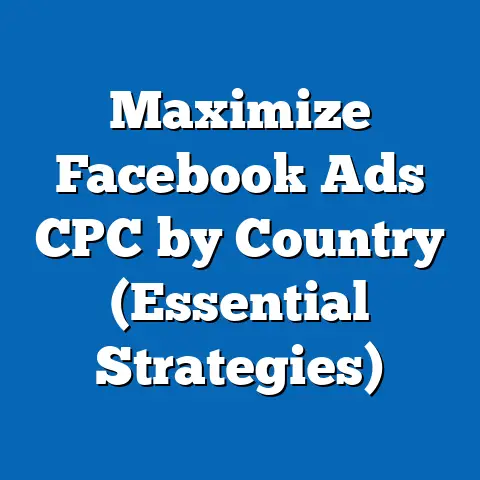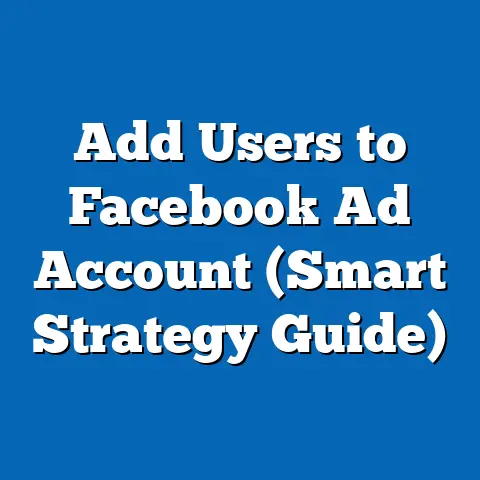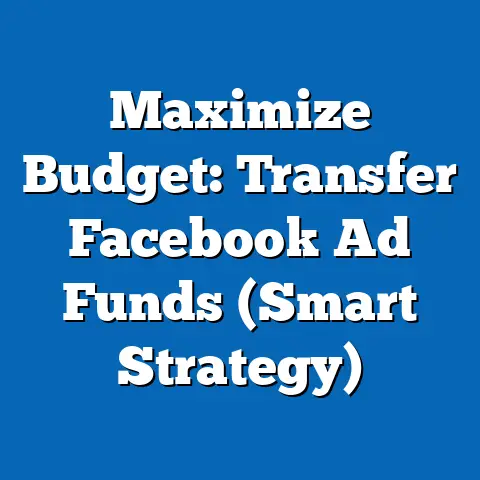Unlocking Optimal CTR on Facebook Ads (Expert Insights)
In today’s digital landscape, where attention spans are shorter than ever, and social media feeds are overflowing with content, capturing a user’s interest is a monumental challenge. Facebook advertising, despite its complexities, remains a powerful tool for reaching targeted audiences. However, simply creating an ad isn’t enough. The visual appeal and design elements of your ads play a crucial role in grabbing attention and driving engagement. In this article, I’ll delve into how modern aesthetics, combined with expert insights, can help you unlock an optimal Click-Through Rate (CTR) for your Facebook ads. I’ll share my experiences, insights, and strategies that I’ve learned over the years to help you achieve better results.
The evolution of design trends in online advertising has been significant. From static banner ads to dynamic video ads, consumer preferences have constantly shifted. Staying ahead of the curve and understanding what resonates with your audience is paramount. I’ve seen firsthand how a well-designed ad can outperform a poorly designed one, even with the same targeting and budget. Let’s explore how you can elevate your Facebook ad game and achieve those coveted clicks.
Understanding Click-Through Rate (CTR)
What is CTR and Why Does It Matter?
Click-Through Rate (CTR) is a metric that measures the percentage of people who see your ad and then click on it. In the context of Facebook ads, it’s a key performance indicator (KPI) that reflects how effective your ad is at capturing attention and driving users to take action. It’s calculated by dividing the number of clicks your ad receives by the number of times it’s shown (impressions), and then multiplying by 100 to get a percentage.
Formula: CTR = (Clicks / Impressions) x 100
For example, if your ad has 1,000 impressions and receives 30 clicks, your CTR would be 3%.
CTR is more than just a number; it’s a reflection of your ad’s relevance, appeal, and overall effectiveness. A higher CTR indicates that your ad is resonating with your target audience, while a lower CTR suggests that there’s room for improvement.
What’s Considered a “Good” CTR?
Determining what constitutes a “good” CTR can be tricky, as it varies depending on several factors, including industry, audience, ad objective, and ad placement. However, I can give you some general benchmarks to consider.
According to industry averages, a good CTR on Facebook is generally considered to be around 1% or higher. However, some industries may see higher or lower averages. For example, industries like retail and e-commerce often have higher CTRs due to the transactional nature of their ads, while others, like finance or healthcare, may have lower CTRs due to stricter regulations and more cautious user behavior.
It’s also important to note that CTR can vary depending on the ad placement. Ads in the Facebook News Feed tend to have higher CTRs than those in the right column, as they’re more visually prominent and integrated into the user’s browsing experience.
Here’s a breakdown of typical CTR benchmarks:
- Below 0.5%: Indicates poor ad performance, requiring significant optimization.
- 0.5% – 1%: Considered average, but still has room for improvement.
- 1% – 2%: A good CTR, indicating that your ad is resonating with your audience.
- Above 2%: Excellent CTR, suggesting that your ad is highly effective.
Implications of CTR for Advertisers
CTR has significant implications for advertisers and businesses:
- Ad Costs: Facebook’s ad algorithm rewards ads with higher CTRs by offering lower costs per click (CPC) and cost per thousand impressions (CPM). This means that if your ads are engaging and relevant, you’ll pay less to reach more people.
- Ad Relevance Score: CTR is a key factor in determining your ad’s relevance score, which is a metric that measures how relevant your ad is to your target audience. A higher relevance score can lead to lower costs and better ad placement.
- Overall Campaign Success: Ultimately, CTR is a strong indicator of your overall campaign success. Higher CTRs translate to more website traffic, leads, and conversions, which can significantly impact your bottom line.
Takeaway: Understanding CTR and its implications is crucial for optimizing your Facebook ad campaigns. By focusing on creating engaging and relevant ads that resonate with your target audience, you can improve your CTR, lower your ad costs, and achieve better results.
The Psychology of Clicks: What Drives User Engagement
Understanding User Behavior on Facebook
To truly optimize your Facebook ads for CTR, you need to understand the psychological factors that drive user behavior on the platform. Facebook users are bombarded with content, so you need to create ads that stand out and capture their attention.
Several psychological principles can influence user engagement, including:
- Curiosity: People are naturally curious, and ads that pique their curiosity are more likely to be clicked. This can be achieved through intriguing headlines, thought-provoking questions, or visually appealing images that leave the user wanting to know more.
- Urgency: Creating a sense of urgency can motivate users to take action immediately. This can be done through limited-time offers, countdown timers, or language that emphasizes scarcity.
- Emotional Triggers: Emotions play a significant role in decision-making. Ads that evoke positive emotions like joy, excitement, or nostalgia are more likely to be clicked. Conversely, ads that address pain points or frustrations can also be effective, as they offer a solution to a problem.
Color Psychology, Visual Hierarchy, and Imagery
- Color Psychology: Colors evoke different emotions and associations. For example, blue is often associated with trust and reliability, while red can create a sense of excitement and urgency. Understanding color psychology can help you choose colors that resonate with your target audience and align with your brand’s messaging.
- Visual Hierarchy: Visual hierarchy refers to the arrangement of visual elements in a way that guides the viewer’s eye and emphasizes important information. By using techniques like size, contrast, and placement, you can create a clear visual hierarchy that draws attention to key elements, such as the headline or call to action.
- Imagery: High-quality images and videos are essential for capturing attention and conveying your message effectively. Choose visuals that are relevant to your target audience, visually appealing, and representative of your brand. User-generated content (UGC) can be particularly effective, as it feels more authentic and relatable.
Statistics and Studies
Several studies support the connection between psychological principles and CTR performance. For example, a study by HubSpot found that headlines that include numbers generate 36% more clicks than those that don’t. Similarly, a study by Neil Patel found that using emotional words in headlines can increase CTR by as much as 29%.
Takeaway: Understanding the psychology of clicks is crucial for creating Facebook ads that resonate with your target audience and drive engagement. By incorporating principles like curiosity, urgency, and emotional triggers, and by paying attention to color psychology, visual hierarchy, and imagery, you can significantly improve your CTR and achieve better results.
Crafting Compelling Ad Copy
Elements of Effective Ad Copy
Ad copy is your opportunity to communicate your message clearly and persuasively. Effective ad copy should be:
- Example 1: “Tired of slow internet? Get lightning-fast speeds with [Your Company Name]. Switch today and save 50% for the first 3 months! Shop Now.”
- Analysis: This ad copy is clear, concise, and benefit-oriented. It addresses a common pain point (slow internet), offers a solution (lightning-fast speeds), and provides a compelling offer (50% off). The CTA (“Shop Now”) is clear and direct.
- Example 2: “Discover the secret to flawless skin! Our new [Product Name] is clinically proven to reduce wrinkles and improve skin tone. Try it risk-free for 30 days! Learn More.”
- Analysis: This ad copy is intriguing and benefit-oriented. It promises a desirable outcome (flawless skin) and highlights the product’s key benefits (reduces wrinkles, improves skin tone). The offer of a risk-free trial reduces the barrier to entry. The CTA (“Learn More”) encourages users to explore further.
- Example 3: “Don’t miss out! Our biggest sale of the year ends tonight. Save up to 70% on all your favorite items. Shop Now!”
- Analysis: This ad copy creates a sense of urgency and scarcity. It emphasizes the limited-time nature of the offer and highlights the potential savings. The CTA (“Shop Now”) is clear and direct.
- Analysis: This ad copy is clear, concise, and benefit-oriented. It addresses a common pain point (slow internet), offers a solution (lightning-fast speeds), and provides a compelling offer (50% off). The CTA (“Shop Now”) is clear and direct.
- Analysis: This ad copy is intriguing and benefit-oriented. It promises a desirable outcome (flawless skin) and highlights the product’s key benefits (reduces wrinkles, improves skin tone). The offer of a risk-free trial reduces the barrier to entry. The CTA (“Learn More”) encourages users to explore further.
- Analysis: This ad copy creates a sense of urgency and scarcity. It emphasizes the limited-time nature of the offer and highlights the potential savings. The CTA (“Shop Now”) is clear and direct.
Aligning Ad Copy with Your Target Audience
It’s crucial to align your ad copy with your target audience’s needs, desires, and pain points. This requires understanding their demographics, interests, and motivations. Conduct thorough audience research to identify the language and messaging that resonates with them.
For example, if you’re targeting millennials, you might use a more casual and conversational tone, and focus on values like authenticity and social impact. If you’re targeting baby boomers, you might use a more formal tone and focus on values like reliability and security.
Takeaway: Crafting compelling ad copy is essential for driving CTR. By using clear, concise, and benefit-oriented language, and by aligning your messaging with your target audience’s needs and desires, you can create ads that capture attention and motivate users to take action.
Visual Elements that Enhance CTR
The Power of Visuals in Facebook Ads
Visuals are the first thing that catches a user’s eye when scrolling through their Facebook feed. High-quality images and videos are essential for capturing attention and conveying your message effectively.
- Images: Choose images that are visually appealing, relevant to your target audience, and representative of your brand. Use high-resolution images that are clear and crisp. Avoid stock photos that look generic or staged.
- Videos: Videos are highly engaging and can be used to tell a story, showcase your product, or provide valuable information. Keep your videos short and to the point, and optimize them for mobile viewing. Use captions to make your videos accessible to users who have their sound turned off.
Types of Visual Content
- Carousel Ads: Carousel ads allow you to showcase multiple images or videos in a single ad unit. This format is ideal for showcasing a range of products, highlighting different features, or telling a story.
- Video Ads: Video ads are highly engaging and can be used to capture attention and convey your message effectively. Use videos to showcase your product, tell a story, or provide valuable information.
- User-Generated Content (UGC): UGC is content created by your customers or fans. It feels more authentic and relatable than traditional advertising, and can be highly effective at driving engagement. Encourage your customers to share their experiences with your product or service, and feature their content in your ads.
Case Studies
Let’s look at some case studies of successful campaigns that effectively utilized visual elements to boost engagement and clicks:
- Case Study 1: A clothing retailer used carousel ads to showcase their new spring collection. Each image featured a different outfit, and the ad copy highlighted the key features and benefits of each item. The campaign resulted in a 30% increase in CTR compared to their previous campaigns.
- Case Study 2: A travel company used video ads to showcase the beauty and excitement of their destinations. The videos featured stunning footage of exotic locations, and the ad copy highlighted the unique experiences that travelers could have. The campaign resulted in a 40% increase in bookings compared to their previous campaigns.
- Case Study 3: A food delivery service used UGC to showcase the deliciousness and convenience of their service. The ads featured photos and videos of customers enjoying their meals, and the ad copy highlighted the ease of ordering and the speed of delivery. The campaign resulted in a 25% increase in orders compared to their previous campaigns.
Takeaway: Visual elements play a crucial role in driving CTR. By using high-quality images and videos, and by experimenting with different types of visual content, you can create ads that capture attention, convey your message effectively, and drive engagement.
Targeting and Retargeting Strategies
The Significance of Audience Targeting
Audience targeting is the process of identifying and reaching the specific group of people who are most likely to be interested in your product or service. Facebook offers a range of targeting options, including:
- Demographic Targeting: Target users based on their age, gender, location, education, and other demographic factors.
- Interest-Based Targeting: Target users based on their interests, hobbies, and activities.
- Behavioral Targeting: Target users based on their past behavior on Facebook and other websites.
- Custom Audiences: Create custom audiences based on your existing customer data, such as email addresses or phone numbers.
- Lookalike Audiences: Create lookalike audiences based on your existing customer data. Facebook will identify users who share similar characteristics and behaviors with your existing customers, allowing you to reach a broader audience of potential customers.
The Role of Retargeting
Retargeting is the process of reaching users who have previously interacted with your brand. This can include users who have visited your website, viewed your products, added items to their cart, or engaged with your Facebook page.
Retargeting is a highly effective way to improve CTR, as you’re reaching users who have already shown an interest in your product or service. By showing them relevant ads that remind them of your brand and encourage them to take action, you can significantly increase your chances of conversion.
Best Practices for Targeting Strategies
- Define Your Target Audience: Before you start creating your ads, take the time to define your target audience. Who are they? What are their interests? What are their pain points? The more specific you can be, the better you’ll be able to target your ads effectively.
- Experiment with Different Targeting Options: Don’t be afraid to experiment with different targeting options to see what works best for your business. Try combining demographic, interest-based, and behavioral targeting to reach a highly targeted audience.
- Use Custom Audiences and Lookalike Audiences: Leverage your existing customer data to create custom audiences and lookalike audiences. This will allow you to reach a broader audience of potential customers who are similar to your existing customers.
- Retarget Users Who Have Interacted with Your Brand: Retarget users who have visited your website, viewed your products, added items to their cart, or engaged with your Facebook page. Show them relevant ads that remind them of your brand and encourage them to take action.
Takeaway: Targeting and retargeting are essential for optimizing CTR. By identifying and reaching the specific group of people who are most likely to be interested in your product or service, and by retargeting users who have previously interacted with your brand, you can significantly improve your CTR and achieve better results.
Conclusion
Unlocking optimal CTR on Facebook ads requires a multifaceted approach that combines modern aesthetics, compelling ad copy, and strategic targeting. By understanding the psychology of clicks, crafting clear and concise ad copy, using high-quality visuals, and targeting the right audience, you can create ads that capture attention, drive engagement, and achieve better results.
I encourage you to experiment with these expert insights to enhance your advertising efforts and achieve better results. Analyze your data, test different approaches, and continuously optimize your campaigns based on what you learn. With dedication and a strategic mindset, you can unlock the full potential of Facebook advertising and achieve your business goals.
Remember, the key to success is to stay informed, stay creative, and always strive to improve your ads based on the latest trends and best practices. Good luck, and happy advertising!




